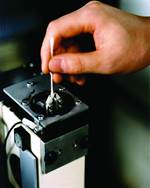Reducing Energy Usage with Wire EDM
Technology advances have helped make today’s EDMs environmentally friendly.
Wire EDM machines are, by nature, fairly large users of energy, due to the fact that they employ electrical spark erosion. This requires a generator/power supply to convert the standard three-phase current into cutting pulses, and to run all the servo drive and pump motors to support the process. Ten or 15 years ago, many EDM machines used DC-type power supplies to generate the spark—and many of these machines are still in operation today.
Wire EDM uses a very high-ignition pulse to encourage ionization of dielectric water, which then creates the cutting pulse. The energy required to kick off that spark is actually too much for the remainder of the cutting spark, and the excess energy is filtered off through a bank of resistors—a process that produces excess heat that a shop must counter with air conditioning.
Older machines use a fluid system that has three pumps: one for filtering the water, a small one for cycling the resin system and a large pump for the main high-pressure system. The filter pump runs all the time and the main pump runs at the same speed whether it is cutting or sitting idle—so the fluid is constantly circulating to maintain thermal stability. This becomes a significant drain on energy.
Today’s machines are more environmentally friendly—having evolved in many areas to dramatically reduce their energy footprint. Digital anti-electrolysis generators do a better job of shaping the cutting pulse and reducing the ions generated in the water; this reduces the load on the DI resin system—allowing it to last up to three times longer. Some systems use a power regeneration circuit, which stores the over-current to create the next ignition pulse. This eliminates the bank of resistors found on the old DC generator—and the heat they produce—for decreased energy usage.
New fluid systems have more pumps that are designed specifically for various functions, and therefore run less often. The main pump is now an inverter-type unit that changes speed to control water volume and pressure and only pushes water to the cutting heads when the machine is running. Separate, smaller pumps now manage the fluid circulation system—running water through the chiller and the machine to maintain thermal stability at a much lower cost. The machine can also operate in a cost save mode that reduces wire consumption and puts the machine to sleep after the job is complete; in this sleep mode, the energy usage is equal to that of a 100-watt light bulb.
The other areas of power consumption on a wire EDM are the axes’ drive motors and the wire drive/tensioning system. While these are not quite as significant as the power supply and pump motors, refinements over the years have improved function and efficiency. Powder magnetic brakes are now DC motors and analog DC servo motors are now digital AC servo systems that use a fraction of the energy to operate. Today’s machines consume about 30 percent less energy than older machines.
Related Content
-
Treatment and Disposal of Used Metalworking Fluids
With greater emphasis on fluid longevity and fluid recycling, it is important to remember that water-based metalworking fluids are “consumable” and have a finite life.
-
Revisiting Some Hot Runner Fundamentals
What exactly does a hot runner do? If you’ve been in the injection molding industry for any length of time, you might think the answer is obvious, but it is not.
-
Machine Hammer Peening Automates Mold Polishing
A polishing automation solution eliminates hand work, accelerates milling operations and controls surface geometries.















